中西婚俗差异
- 格式:doc
- 大小:476.00 KB
- 文档页数:20
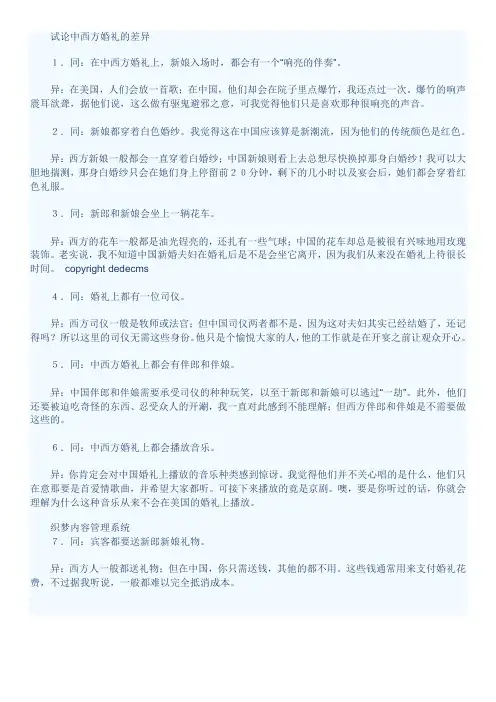
试论中西方婚礼的差异1.同:在中西方婚礼上,新娘入场时,都会有一个“响亮的伴奏”。
异:在美国,人们会放一首歌;在中国,他们却会在院子里点爆竹,我还点过一次。
爆竹的响声震耳欲聋,据他们说,这么做有驱鬼避邪之意,可我觉得他们只是喜欢那种很响亮的声音。
2.同:新娘都穿着白色婚纱。
我觉得这在中国应该算是新潮流,因为他们的传统颜色是红色。
异:西方新娘一般都会一直穿着白婚纱;中国新娘则看上去总想尽快换掉那身白婚纱!我可以大胆地揣测,那身白婚纱只会在她们身上停留前20分钟,剩下的几小时以及宴会后,她们都会穿着红色礼服。
3.同:新郎和新娘会坐上一辆花车。
异:西方的花车一般都是油光锃亮的,还扎有一些气球;中国的花车却总是被很有兴味地用玫瑰装饰。
老实说,我不知道中国新婚夫妇在婚礼后是不是会坐它离开,因为我们从来没在婚礼上待很长时间。
copyright dedecms4.同:婚礼上都有一位司仪。
异:西方司仪一般是牧师或法官;但中国司仪两者都不是,因为这对夫妇其实已经结婚了,还记得吗?所以这里的司仪无需这些身份。
他只是个愉悦大家的人,他的工作就是在开宴之前让观众开心。
5.同:中西方婚礼上都会有伴郎和伴娘。
异:中国伴郎和伴娘需要承受司仪的种种玩笑,以至于新郎和新娘可以逃过“一劫”。
此外,他们还要被迫吃奇怪的东西、忍受众人的开涮,我一直对此感到不能理解;但西方伴郎和伴娘是不需要做这些的。
6.同:中西方婚礼上都会播放音乐。
异:你肯定会对中国婚礼上播放的音乐种类感到惊讶。
我觉得他们并不关心唱的是什么,他们只在意那要是首爱情歌曲,并希望大家都听。
可接下来播放的竟是京剧。
噢,要是你听过的话,你就会理解为什么这种音乐从来不会在美国的婚礼上播放。
织梦内容管理系统7.同:宾客都要送新郎新娘礼物。
异:西方人一般都送礼物;但在中国,你只需送钱,其他的都不用。
这些钱通常用来支付婚礼花费,不过据我听说,一般都难以完全抵消成本。
首先,是在传统结婚仪式上面。
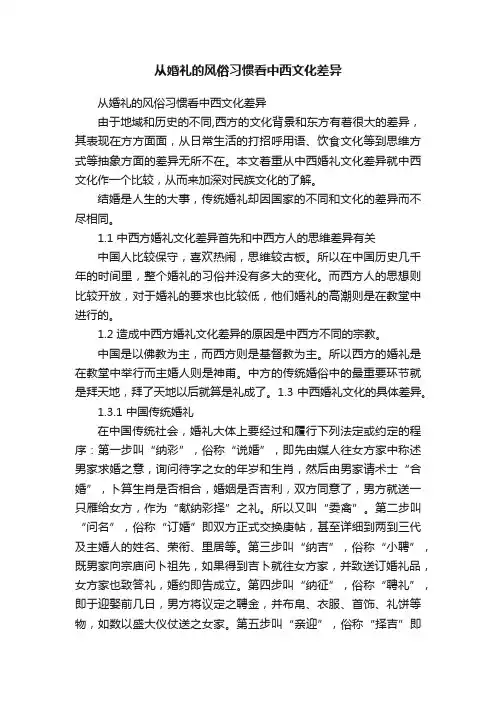
从婚礼的风俗习惯看中西文化差异从婚礼的风俗习惯看中西文化差异由于地域和历史的不同,西方的文化背景和东方有着很大的差异,其表现在方方面面,从日常生活的打招呼用语、饮食文化等到思维方式等抽象方面的差异无所不在。
本文着重从中西婚礼文化差异就中西文化作一个比较,从而来加深对民族文化的了解。
结婚是人生的大事,传统婚礼却因国家的不同和文化的差异而不尽相同。
1.1 中西方婚礼文化差异首先和中西方人的思维差异有关中国人比较保守,喜欢热闹,思维较古板。
所以在中国历史几千年的时间里,整个婚礼的习俗并没有多大的变化。
而西方人的思想则比较开放,对于婚礼的要求也比较低,他们婚礼的高潮则是在教堂中进行的。
1.2 造成中西方婚礼文化差异的原因是中西方不同的宗教。
中国是以佛教为主,而西方则是基督教为主。
所以西方的婚礼是在教堂中举行而主婚人则是神甫。
中方的传统婚俗中的最重要环节就是拜天地,拜了天地以后就算是礼成了。
1.3 中西婚礼文化的具体差异。
1.3.1 中国传统婚礼在中国传统社会,婚礼大体上要经过和履行下列法定或约定的程序:第一步叫“纳彩”,俗称“说婚”,即先由媒人往女方家中称述男家求婚之意,询问待字之女的年岁和生肖,然后由男家请术士“合婚”,卜算生肖是否相合,婚姻是否吉利,双方同意了,男方就送一只雁给女方,作为“献纳彩择”之礼。
所以又叫“委禽”。
第二步叫“问名”,俗称“订婚”即双方正式交换庚帖,甚至详细到两到三代及主婚人的姓名、荣衔、里居等。
第三步叫“纳吉”,俗称“小聘”,既男家向宗庙问卜祖先,如果得到吉卜就往女方家,并致送订婚礼品,女方家也致答礼,婚约即告成立。
第四步叫“纳征”,俗称“聘礼”,即于迎娶前几日,男方将议定之聘金,并布帛、衣服、首饰、礼饼等物,如数以盛大仪仗送之女家。
第五步叫“亲迎”,俗称“择吉”即由男方家择定迎娶之吉日,并通知女方家。
第六步叫“亲迎”即在喜结良缘之日,新郎躬率鼓乐、仪仗、花轿,到女家以礼迎娶新娘,并一同归家。
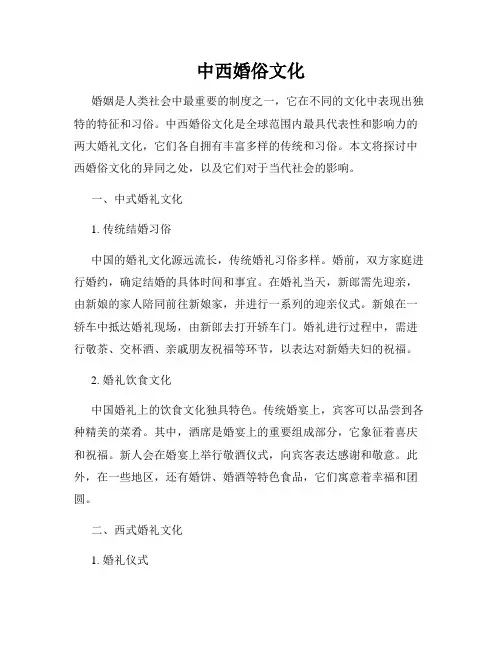
中西婚俗文化婚姻是人类社会中最重要的制度之一,它在不同的文化中表现出独特的特征和习俗。
中西婚俗文化是全球范围内最具代表性和影响力的两大婚礼文化,它们各自拥有丰富多样的传统和习俗。
本文将探讨中西婚俗文化的异同之处,以及它们对于当代社会的影响。
一、中式婚礼文化1. 传统结婚习俗中国的婚礼文化源远流长,传统婚礼习俗多样。
婚前,双方家庭进行婚约,确定结婚的具体时间和事宜。
在婚礼当天,新郎需先迎亲,由新娘的家人陪同前往新娘家,并进行一系列的迎亲仪式。
新娘在一轿车中抵达婚礼现场,由新郎去打开轿车门。
婚礼进行过程中,需进行敬茶、交杯酒、亲戚朋友祝福等环节,以表达对新婚夫妇的祝福。
2. 婚礼饮食文化中国婚礼上的饮食文化独具特色。
传统婚宴上,宾客可以品尝到各种精美的菜肴。
其中,酒席是婚宴上的重要组成部分,它象征着喜庆和祝福。
新人会在婚宴上举行敬酒仪式,向宾客表达感谢和敬意。
此外,在一些地区,还有婚饼、婚酒等特色食品,它们寓意着幸福和团圆。
二、西式婚礼文化1. 婚礼仪式西方婚礼仪式注重个性和浪漫,常以教堂为场地举行。
婚礼前,新郎新娘会选择婚纱礼服,新娘会戴上精美的婚纱头纱。
婚礼仪式中,新郎新娘在神父的主持下进行誓言的宣读和交换婚戒等环节。
同时,婚礼上也会有朋友和亲人的祝福演讲,以及音乐、舞蹈等表演。
2. 婚礼蛋糕与舞会西方婚礼上的蛋糕是一大亮点。
新人会在婚礼上展示一座精美的多层结婚蛋糕,蛋糕通常以新人的个人喜好来设计,上面还会有新人的名字和婚礼日期。
此外,西方婚礼常以舞会的形式结束。
新人会在伴郎伴娘和宾客的见证下,进行第一支新婚舞曲,并邀请宾客一起舞蹈和庆祝。
三、中西婚俗文化的异同1. 婚礼形式中式和西式婚礼在形式上存在明显差异。
中式婚礼以家庭为单位,注重家族和亲戚的参与,婚礼形式庄重而热闹。
西式婚礼更加注重个人的选择和个性化,以新人为中心,舞会和婚礼仪式更加浪漫和隆重。
2. 礼仪习俗中西婚礼的礼仪习俗也有所不同。
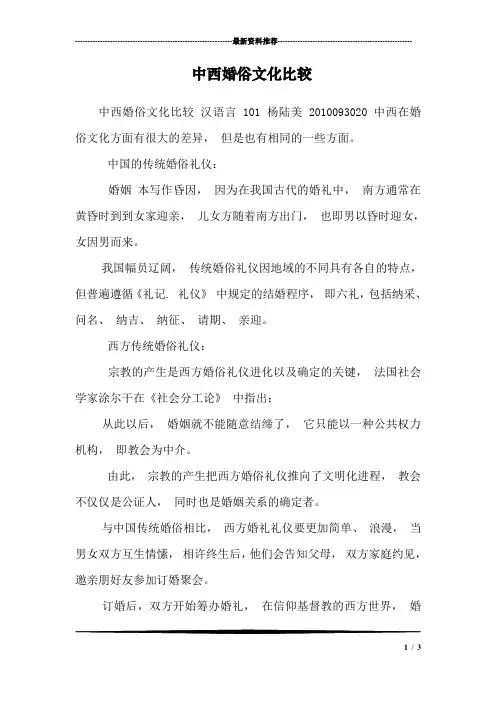
---------------------------------------------------------------最新资料推荐------------------------------------------------------中西婚俗文化比较中西婚俗文化比较汉语言 101 杨陆美 2010093020 中西在婚俗文化方面有很大的差异,但是也有相同的一些方面。
中国的传统婚俗礼仪:婚姻本写作昏因,因为在我国古代的婚礼中,南方通常在黄昏时到到女家迎亲,儿女方随着南方出门,也即男以昏时迎女,女因男而来。
我国幅员辽阔,传统婚俗礼仪因地域的不同具有各自的特点,但普遍遵循《礼记. 礼仪》中规定的结婚程序,即六礼,包括纳采、问名、纳吉、纳征、请期、亲迎。
西方传统婚俗礼仪:宗教的产生是西方婚俗礼仪进化以及确定的关键,法国社会学家涂尔干在《社会分工论》中指出:从此以后,婚姻就不能随意结缔了,它只能以一种公共权力机构,即教会为中介。
由此,宗教的产生把西方婚俗礼仪推向了文明化进程,教会不仅仅是公证人,同时也是婚姻关系的确定者。
与中国传统婚俗相比,西方婚礼礼仪要更加简单、浪漫,当男女双方互生情愫,相许终生后,他们会告知父母,双方家庭约见,邀亲朋好友参加订婚聚会。
订婚后,双方开始筹办婚礼,在信仰基督教的西方世界,婚1 / 3礼一般在教堂举行。
中西婚俗文化差异:1、婚姻的社会地位在中国传统观念中,婚姻是天地人伦的基础,伦常礼仪、社会组织都基于婚姻。
庞大的家族体系,复杂的社会关系,严密的封建礼制,婚姻里爱的成分逐渐减少,礼的成分逐渐增加,最终丧失了独立自主性,沦为了保持家庭社会和谐稳定的因子,婚姻的目的也顺理成章地变成了繁衍后代,壮大家族,维护和提高家族的声望和地位。
在西方文化文化中,婚姻是神赐予的礼物。
履行婚姻就是遵循上帝的旨意,体现神与人所立的盟约。
而且婚姻的选择倾向于在相等或相近的声望阶级之间发生,但不同阶级之间的通婚并没有严格的法律限制,当事人拥有比较大的自主性。
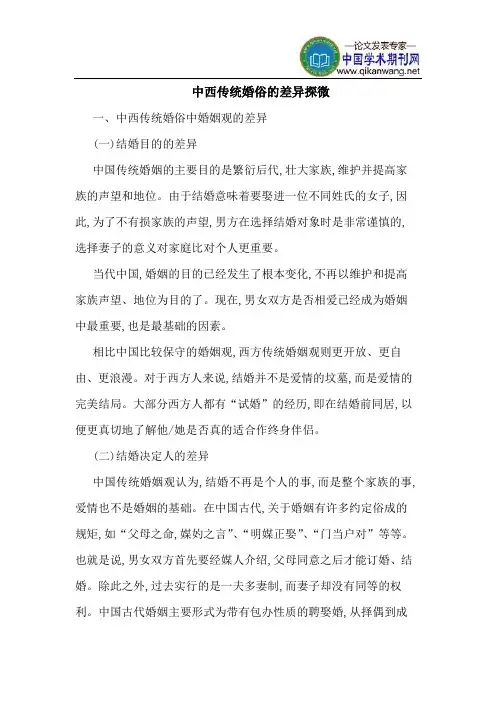
中西传统婚俗的差异探微一、中西传统婚俗中婚姻观的差异(一)结婚目的的差异中国传统婚姻的主要目的是繁衍后代,壮大家族,维护并提高家族的声望和地位。
由于结婚意味着要娶进一位不同姓氏的女子,因此,为了不有损家族的声望,男方在选择结婚对象时是非常谨慎的,选择妻子的意义对家庭比对个人更重要。
当代中国,婚姻的目的已经发生了根本变化,不再以维护和提高家族声望、地位为目的了。
现在,男女双方是否相爱已经成为婚姻中最重要,也是最基础的因素。
相比中国比较保守的婚姻观,西方传统婚姻观则更开放、更自由、更浪漫。
对于西方人来说,结婚并不是爱情的坟墓,而是爱情的完美结局。
大部分西方人都有“试婚”的经历,即在结婚前同居,以便更真切地了解他/她是否真的适合作终身伴侣。
(二)结婚决定人的差异中国传统婚姻观认为,结婚不再是个人的事,而是整个家族的事,爱情也不是婚姻的基础。
在中国古代,关于婚姻有许多约定俗成的规矩,如“父母之命,媒妁之言”、“明媒正娶”、“门当户对”等等。
也就是说,男女双方首先要经媒人介绍,父母同意之后才能订婚、结婚。
除此之外,过去实行的是一夫多妻制,而妻子却没有同等的权利。
中国古代婚姻主要形式为带有包办性质的聘娶婚,从择偶到成婚,由媒人和父母做主,讲究“父母之命,媒妁之言”(曲彦斌,2000)。
很多情况下,男女双方在结婚之前是相互不认识的。
这种婚姻模式使得女性在婚姻中没有经济来源,变成了婚姻和丈夫的附属品,形成了男尊女卑的婚姻结构。
而当代中国和西方传统婚姻观则认为爱情是婚姻的基础,年轻人可以自由选择自己的爱人,父母很少干涉。
西方国家的父母对儿女的婚姻甚至都没有决定权。
情侣们为了爱而结婚,而不是为了家族的声望和地位。
二、中西传统婚俗中婚礼仪式的差异(一)婚礼地点的差异在中国婚礼上,人们将传统的喜庆与热闹,把吉祥和祝福以最热烈的方式送给一对喜结连理的新人。
中国婚礼的地点一般都安排在双方家里,这样比较热闹。
西方婚礼仪式没有中国婚礼仪式那样复杂,程序化,而是更加的庄重神圣。
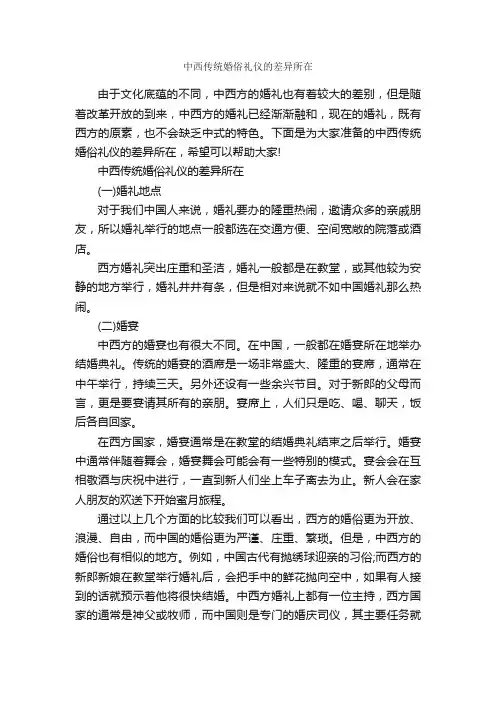
中西传统婚俗礼仪的差异所在由于文化底蕴的不同,中西方的婚礼也有着较大的差别,但是随着改革开放的到来,中西方的婚礼已经渐渐融和,现在的婚礼,既有西方的原素,也不会缺乏中式的特色。
下面是为大家准备的中西传统婚俗礼仪的差异所在,希望可以帮助大家!中西传统婚俗礼仪的差异所在(一)婚礼地点对于我们中国人来说,婚礼要办的隆重热闹,邀请众多的亲戚朋友,所以婚礼举行的地点一般都选在交通方便、空间宽敞的院落或酒店。
西方婚礼突出庄重和圣洁,婚礼一般都是在教堂,或其他较为安静的地方举行,婚礼井井有条,但是相对来说就不如中国婚礼那么热闹。
(二)婚宴中西方的婚宴也有很大不同。
在中国,一般都在婚宴所在地举办结婚典礼。
传统的婚宴的酒席是一场非常盛大、隆重的宴席,通常在中午举行,持续三天。
另外还设有一些余兴节目。
对于新郎的父母而言,更是要宴请其所有的亲朋。
宴席上,人们只是吃、喝、聊天,饭后各自回家。
在西方国家,婚宴通常是在教堂的结婚典礼结束之后举行。
婚宴中通常伴随着舞会,婚宴舞会可能会有一些特别的模式。
宴会会在互相敬酒与庆祝中进行,一直到新人们坐上车子离去为止。
新人会在家人朋友的欢送下开始蜜月旅程。
通过以上几个方面的比较我们可以看出,西方的婚俗更为开放、浪漫、自由,而中国的婚俗更为严谨、庄重、繁琐。
但是,中西方的婚俗也有相似的地方。
例如,中国古代有抛绣球迎亲的习俗;而西方的新郎新娘在教堂举行婚礼后,会把手中的鲜花抛向空中,如果有人接到的话就预示着他将很快结婚。
中西方婚礼上都有一位主持,西方国家的通常是神父或牧师,而中国则是专门的婚庆司仪,其主要任务就是使婚礼更加热闹,亲戚朋友更加开心。
中西传统婚俗礼仪的差异西方教堂试婚礼,有神父宣读誓词中国婚礼需要拜天地、拜高堂、夫妻对拜中西方婚礼的差别-中西方国家喜宴形式不同中式喜宴的酒席很大一部分的内容是亲朋好友热闹地聚在一起进餐,另外还设有一些余兴节目。
在宴席中间新娘一般换1至2套衣服,迎宾时新娘先穿白色婚纱,敬酒时再换上极富个性色彩的衣服。
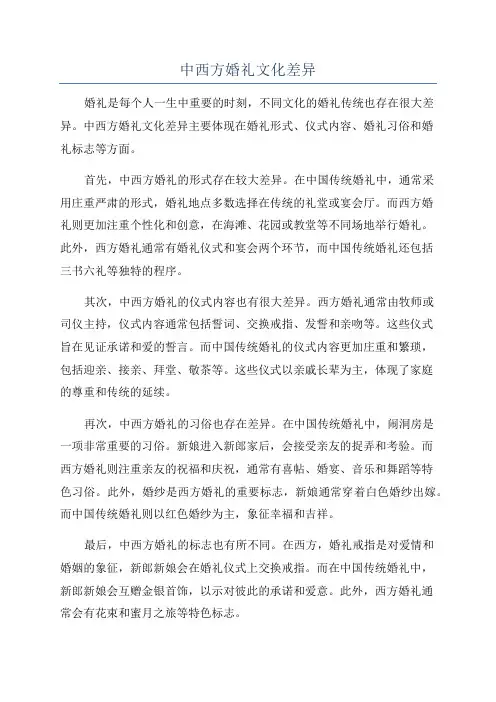
中西方婚礼文化差异婚礼是每个人一生中重要的时刻,不同文化的婚礼传统也存在很大差异。
中西方婚礼文化差异主要体现在婚礼形式、仪式内容、婚礼习俗和婚礼标志等方面。
首先,中西方婚礼的形式存在较大差异。
在中国传统婚礼中,通常采用庄重严肃的形式,婚礼地点多数选择在传统的礼堂或宴会厅。
而西方婚礼则更加注重个性化和创意,在海滩、花园或教堂等不同场地举行婚礼。
此外,西方婚礼通常有婚礼仪式和宴会两个环节,而中国传统婚礼还包括三书六礼等独特的程序。
其次,中西方婚礼的仪式内容也有很大差异。
西方婚礼通常由牧师或司仪主持,仪式内容通常包括誓词、交换戒指、发誓和亲吻等。
这些仪式旨在见证承诺和爱的誓言。
而中国传统婚礼的仪式内容更加庄重和繁琐,包括迎亲、接亲、拜堂、敬茶等。
这些仪式以亲戚长辈为主,体现了家庭的尊重和传统的延续。
再次,中西方婚礼的习俗也存在差异。
在中国传统婚礼中,闹洞房是一项非常重要的习俗。
新娘进入新郎家后,会接受亲友的捉弄和考验。
而西方婚礼则注重亲友的祝福和庆祝,通常有喜帖、婚宴、音乐和舞蹈等特色习俗。
此外,婚纱是西方婚礼的重要标志,新娘通常穿着白色婚纱出嫁。
而中国传统婚礼则以红色婚纱为主,象征幸福和吉祥。
最后,中西方婚礼的标志也有所不同。
在西方,婚礼戒指是对爱情和婚姻的象征,新郎新娘会在婚礼仪式上交换戒指。
而在中国传统婚礼中,新郎新娘会互赠金银首饰,以示对彼此的承诺和爱意。
此外,西方婚礼通常会有花束和蜜月之旅等特色标志。
总之,中西方婚礼文化存在诸多差异。
中西方婚礼形式、仪式内容、婚礼习俗和婚礼标志都有不同的特点和传统。
这些文化差异体现了中西方婚礼的独特魅力,也展示了不同文化对爱情和婚姻的不同诠释。
无论是中式婚礼还是西式婚礼,每一种都有着自己独特的魅力和价值,都能营造出浓郁的喜庆氛围。

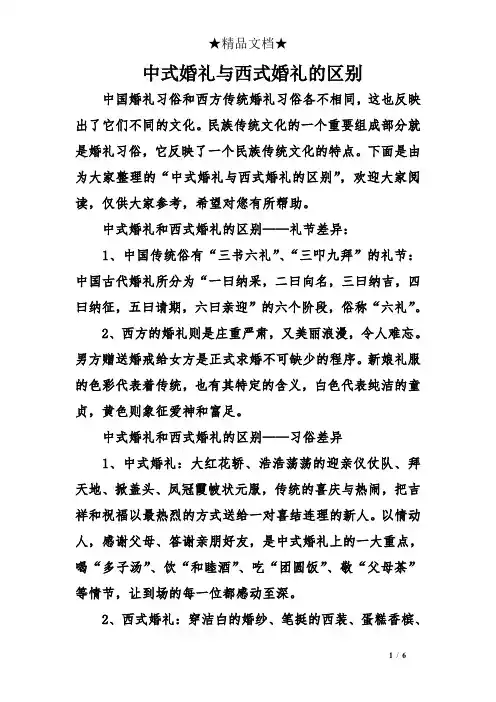
中式婚礼与西式婚礼的区别中国婚礼习俗和西方传统婚礼习俗各不相同,这也反映出了它们不同的文化。
民族传统文化的一个重要组成部分就是婚礼习俗,它反映了一个民族传统文化的特点。
下面是由为大家整理的“中式婚礼与西式婚礼的区别”,欢迎大家阅读,仅供大家参考,希望对您有所帮助。
中式婚礼和西式婚礼的区别——礼节差异:1、中国传统俗有“三书六礼”、“三叩九拜”的礼节:中国古代婚礼所分为“一曰纳采,二曰向名,三曰纳吉,四曰纳征,五曰请期,六曰亲迎”的六个阶段,俗称“六礼”。
2、西方的婚礼则是庄重严肃,又美丽浪漫,令人难忘。
男方赠送婚戒给女方是正式求婚不可缺少的程序。
新娘礼服的色彩代表着传统,也有其特定的含义,白色代表纯洁的童贞,黄色则象征爱神和富足。
中式婚礼和西式婚礼的区别——习俗差异1、中式婚礼:大红花轿、浩浩荡荡的迎亲仪仗队、拜天地、掀盖头、凤冠霞帔状元服,传统的喜庆与热闹,把吉祥和祝福以最热烈的方式送给一对喜结连理的新人。
以情动人,感谢父母、答谢亲朋好友,是中式婚礼上的一大重点,喝“多子汤”、饮“和睦酒”、吃“团圆饭”、敬“父母茶”等情节,让到场的每一位都感动至深。
2、西式婚礼:穿洁白的婚纱、笔挺的西装、蛋糕香槟、抛花球。
白色是婚礼上独一无二的主色调,白色的婚纱、白色的布置、白色的蛋糕、白色的婚车。
一切白色的花卉都会成为西式婚礼上最受欢迎的装饰物。
中式婚礼和西式婚礼的区别——举办场所的差异1、中式婚礼的举办场地象征着婚姻中的核心点,一般在新郎家举行,如果婚礼是在新娘家举办的,那么婚姻的核心就在女方。
古时候,新郎要去新郎家接亲,新郞骑着马,新娘则坐在花轿里,人们敲锣打鼓和新人一起去新郎家,等到了新郎家,两个新人就开始举行婚礼,之后,喜宴开始,在场的所有宾客和亲友开始入席。
如今,送嫁迎娶不再用花轿,而是选择花车车队,也有越来越多的新人出于方便选择在酒店置办婚礼,更有时尚潮流的新式婚礼,如草坪婚礼、沙滩婚礼、热气球婚礼等。
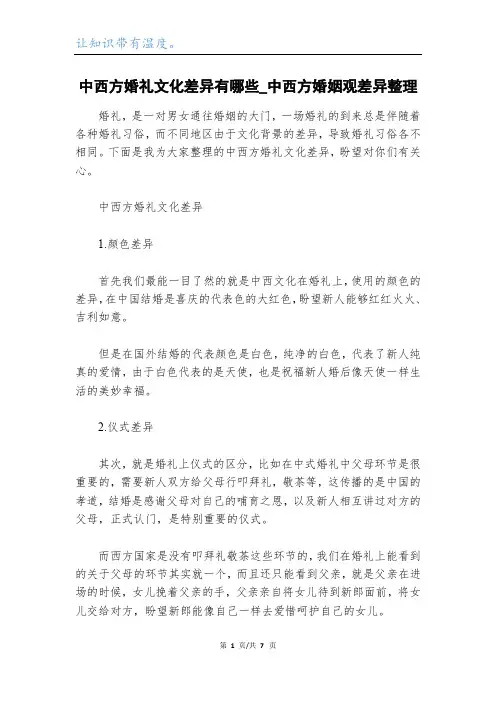
中西方婚礼文化差异有哪些_中西方婚姻观差异整理婚礼,是一对男女通往婚姻的大门,一场婚礼的到来总是伴随着各种婚礼习俗,而不同地区由于文化背景的差异,导致婚礼习俗各不相同。
下面是我为大家整理的中西方婚礼文化差异,盼望对你们有关心。
中西方婚礼文化差异1.颜色差异首先我们最能一目了然的就是中西文化在婚礼上,使用的颜色的差异,在中国结婚是喜庆的代表色的大红色,盼望新人能够红红火火、吉利如意。
但是在国外结婚的代表颜色是白色,纯净的白色,代表了新人纯真的爱情,由于白色代表的是天使,也是祝福新人婚后像天使一样生活的美妙幸福。
2.仪式差异其次,就是婚礼上仪式的区分,比如在中式婚礼中父母环节是很重要的,需要新人双方给父母行叩拜礼,敬茶等,这传播的是中国的孝道,结婚是感谢父母对自己的哺育之恩,以及新人相互讲过对方的父母,正式认门,是特别重要的仪式。
而西方国家是没有叩拜礼敬茶这些环节的,我们在婚礼上能看到的关于父母的环节其实就一个,而且还只能看到父亲,就是父亲在进场的时候,女儿挽着父亲的手,父亲亲自将女儿待到新郎面前,将女儿交给对方,盼望新郎能像自己一样去爱惜呵护自己的女儿。
3.服饰差异中国与西方结婚,服饰上的差异也是巨大的,例如在中国基本采纳的是唐装或者是汉服,女性穿着就是凤冠霞帔、秀禾服、旗袍等等,男士一般都是唐装或者汉服的马褂新郎服。
在西方新娘服饰礼服、婚纱,一般状况下都是婚纱,近年来我国也许多穿婚纱结婚的,男士就是西装,在重要场合男士的服装都是西装,是最得体最隆重的服饰。
4.总结假如是一一列举的话确定还有许多许多,但是近年来的中西方文化的融合进展,相互之间的借鉴接受,形成了许多结合式的婚礼新形势,比如年轻人喜爱西式也喜爱中式的,在迎亲时候采纳中式婚礼格调,酒店仪式的时候采纳西式婚礼,这也是很好的结合,也充分体现了现代多元化的文化时代。
中西方婚礼仪式中式婚礼仪式为什么要射轿帘?花轿停后,新郎手执弓箭,分别向天、地、新娘空射三箭,意喻举箭弓逢凶化吉。
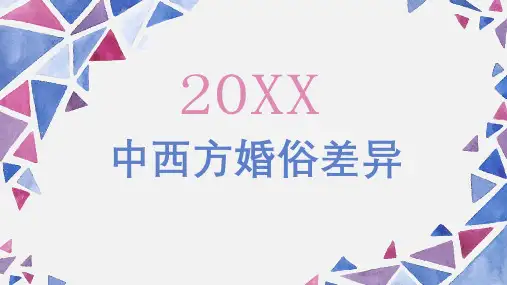
浅析中西方婚礼习俗的差异1. 引言1.1 中西方婚礼习俗的背景中西方婚礼习俗的背景可以追溯到各自文化的历史传统和价值观念。
在中国,婚礼被视为家族的重要事件,是传承血脉和延续家族的方式。
婚礼仪式通常包括订婚、过大礼、举行婚礼等环节,各个环节都有着严格的程序和规矩。
而在西方,婚礼则强调个人的幸福和爱情,婚礼仪式更加注重新人之间的情感表达和承诺。
婚礼仪式通常包括求婚、订婚、举行仪式、举办晚宴等环节。
随着全球化的发展,中西方婚礼习俗之间的交流和融合也日益频繁。
新人们常常会从两种文化中选择他们喜欢的元素,创造出独特的婚礼体验。
中西方婚礼习俗之间的差异也反映出了两种文化的不同价值观和社会风貌。
研究中西方婚礼习俗的差异不仅可以帮助我们更深入地了解各自的文化传统,也有助于促进跨文化交流和理解。
【2000字内容到此结束】1.2 研究意义研究中西方婚礼习俗的意义在于深入了解不同文化背景下人们对于婚姻的理解和认知,反映了社会价值观念的差异和文化传统的多样性。
通过对中西方婚礼习俗的比较分析,可以促进不同文化间的交流与理解,拓展跨文化交流的视野,增进各国人民的友谊与合作。
研究还可以帮助我们更加深入地理解婚姻制度在不同文化中的地位和作用,为婚礼文化的传承与发展提供有益的参考和启示。
探讨中西方婚礼习俗的差异不仅有助于促进文化交流与融合,还可以拓展我们对于人类婚姻制度多样性的认知,丰富我们对于不同文化的理解和尊重,具有重要的研究价值和实践意义。
2. 正文2.1 仪式形式的差异中西方婚礼的仪式形式有着明显的差异,这些差异体现了不同文化对于婚姻的看法和表达方式。
在西方婚礼中,通常会有一段由牧师主持的宗教仪式。
这个仪式通常包括交换誓言、交换戒指、祈祷和领取结婚证书等环节。
而在中国传统婚礼中,主要的仪式是过门仪式和敬茶仪式。
过门仪式是新娘进入新郎家庭的仪式,而敬茶仪式则是对长辈致敬的仪式。
在西方,新娘通常会穿着白色的婚纱,象征着纯洁和圣洁。
中西婚礼习俗对比1、引言自古以来,婚姻是人伦之首,更重要的是人们可以透过纷繁绚丽的婚俗,更清楚的认识人类社会历史,探索人类社会发展的基本规律。
随着中国加入WTO,中国和西方国家间的经济,文化交流日渐频繁,中国和西方国家人民之间的合作与往来与日俱增,这种要求更显迫切。
而婚礼作为将丈夫和妻子之间的关系公开确定下来的一种方式,在每种文化形式中,都有其不同的婚礼习俗。
而在中国与西方国家交流日益密切的形势下,更透彻的了解西方国家的婚礼习俗是必要的。
2、中西婚礼习俗概况2.1中国婚礼习俗的概况几千年来,中国传统婚姻习俗一直实行的是“纳彩、问名、纳吉、纳征、请期、亲迎”的六礼之仪。
中国人传统的婚礼通常在男方家举行。
婚礼当天新郎新娘都穿崭新的传统中式服装,多为红色,以取讨喜、避邪之意;新郎古代多穿九品服,近代多穿长袍马褂,大红花扎在胸前,头戴礼帽,新娘古代多戴凤冠、披霞披,近代则多穿大红花的新衣、长裙,还要头盖红盖头。
迎亲时新郎要骑高头大马,用花轿到新娘家去接新娘。
而新娘上轿时是不能沾地的:或者将花轿抬至屋门口,再由新娘的父兄将其抱上花轿,或者在地上铺上红毯子或席子让新娘踩踏而过;或者在不乘花轿时要由新娘的舅舅或兄弟轮流背至新郎家中。
据说这样可以新娘的身份高贵,同时也不至于把新娘家的财气和福气带走。
迎亲路上还要请过乐队吹吹打打,一路上唢呐声声、锣钹阵阵以示喜庆,返回时还要抬着新娘的各色嫁妆。
抵达新郎家后,新娘要先迈过火盆方可入室,寓意“婚后生活红红火火”。
然后一对新人要在长辈的主持下施行拜堂大礼,一拜天地、二拜高堂、三是夫妻对拜,最后是送入洞房,新郎要揭开新娘的红盖头、和新娘喝合婚酒,亲友们还要请新娘“吃喜糖”,如红枣、花生、栗子等,意为早生贵子,表达了人们希望子孙昌盛的愿望;到了近代还有亲人闹洞房等。
新郎家中还要大摆宴席,招待新娘家的客人,而且新郎还要敬酒。
与此同时,新娘家里的人不是所有的不会都去,俗话有“姑不娶,姨不送;舅妈送,一场病”的说法,意思就是新郎的姑姑不能去迎亲,而新娘的姨妈、舅妈也不能去送亲。
中西国家婚礼文化差异的比较一、仪式流程的差异在中国,婚礼通常分为订婚、请帖、婚前礼仪、婚礼仪式和婚后宴请五个环节。
而在西方国家,婚礼通常包括求婚、筹办婚礼、婚礼仪式和婚后庆祝四个阶段。
中西方婚礼的仪式流程存在明显的差异。
中式婚礼重视家庭的纽带和传承,婚前礼仪中包括过堂和纳彩等传统习俗。
在婚礼仪式中,新郎新妇要行礼向父母致谢,表达对亲人的尊重和感恩之情。
而在西方国家,婚礼强调新人之间的爱情和承诺。
婚礼仪式中的高潮是新郎向新妇戴上戒指,并且交换誓言,以表示他们的彼此承诺和爱情。
二、婚纱的象征意义的差异在中国,婚纱通常是红色的,代表喜庆和祝愿,并且寓意“早生贵子”。
红色具有象征意义,寓意吉祥、好运和幸福。
而在西方,婚纱通常是白色的,代表纯净和纯真。
白色象征着新妇的纯净无瑕和婚姻的纯净无暇。
此外,西方国家的新妇通常会有婚纱秀,展示婚纱的秀丽和设计。
而在中国,新妇通常会换多套礼服,包括传统的汉服和现代的婚纱。
三、婚宴的庆祝形式的差异在中国,婚宴通常是一个巨大的家族聚会。
一般来说,婚宴有多道丰富的菜肴,象征着新人幸福和富有。
整个过程回合且隆重,充盈喜庆的氛围。
婚宴上有鞭炮和舞狮表演等活动,以祝愿新人的幸福和婚姻美满。
而在西方国家,婚宴更像是一场盛大的晚宴。
通常有特殊的庆祝酒水,如香槟,以及美丽的音乐和舞蹈。
同时,新妇和新郎会共同切割婚礼蛋糕,并且屡屡在晚宴上举办新人的第一次舞蹈。
四、婚庆习俗的差异在中国,结婚的日子通常会选择在农历的节气或者黄道吉日,以求得吉利。
婚礼上会进行浩繁传统的习俗,如敬茶、猜灯谜等。
相比之下,西方国家更重视个人的意愿和自由,因此在婚礼的筹办和进行中,新人可以自由选择日期和习俗。
结语中西国家的婚礼文化存在明显的差异。
中式婚礼重视家庭的纽带和传承,强调亲情和尊重。
而西式婚礼强调个人的爱情和承诺,并更加重视新人之间的互动。
无论是中式仍是西式的婚礼,它们都是对人生的一种庄重承诺和美妙祝愿,代表着两个家庭的融合和新的生活开始总的来说,中西婚礼文化存在一些明显的差异。
浅析中西方婚礼习俗的差异婚礼是人类社会中重要的文化现象之一,而中西方婚礼习俗的差异非常显著。
本文将从婚前准备、婚礼仪式、婚礼习俗等方面进行分析。
一、婚前准备1.求婚方式在西方国家,求婚通常是男方向女方求婚,通常会送上鲜花、求婚戒指等礼物。
而在中国,求婚大多数是女方家族的中间人与男方家族联络,面谈后才知道彼此是否合适。
2.婚纱与礼服西方新娘通常会选择白色婚纱,象征纯洁和神圣的爱。
而中国新娘一般穿着红色的嫁衣,象征喜庆和幸福。
3.婚礼场所在西方国家,原则上只需拥有证婚人的权威,便可在任何场所结婚。
而在中国,大多数婚礼仍然选择在宾馆、饭店和婚纱摄影馆等场所举行。
二、婚礼仪式1.主礼人在西方国家,通常会邀请牧师、教士等职业人士来担任主礼人,而在中国则是由婚庆公司的工作人员担任主持。
在中西方婚礼中都有对新郎对新娘的誓言,但内容有所不同。
在西方国家,誓言较为庄重,通常会包含严肃的承诺,如承诺相爱到永远等。
而在中国,新郎新娘在宣誓时则可以加入一些幽默或逗趣的元素,使得仪式更为轻松愉快。
3.喜宴活动在西方国家,主要的喜宴活动通常是先进行祝酒仪式,之后是食物与音乐表演节目等奢华排场。
而在中国,则几乎所有的喜宴活动,都离不开红色,如“一戴靴子二撑伞”、“三照镜子四梳头”、“五看月亮六吃围炉”等等。
有的还会有“糖罐茶杯”、“爬楼梯”等习俗。
三、婚礼习俗1.人数大小在中西方婚礼中,宾客数量有很大的差别。
在西方国家,由于婚礼场所不限,所以婚礼的宾客数量一般较少,常常只有亲朋好友参加。
而在中国,婚礼宾客数量通常较多,尤其是在农村地区,常常要请几百位甚至上千位亲戚和朋友。
2.新娘新郎的角色在婚礼中,新娘和新郎在中西方文化中的角色也有所不同。
在西方国家,新娘通常是主角,而新郎则是配角。
新娘穿着婚纱,扮演公主,新郎则是陪伴者,出席坚定地承诺为妻子负责直到永远。
而在中国,新郎扮演的角色要明显高于新娘。
在婚礼中,新郎负责接新娘到家,准备房间、敬父母等,而新娘则要遵守传统习俗,如磨耳朵、拜堂、三鞠躬、献花、跳花轿等。
二、中西方婚姻方面的不同(一)结婚方面的不同1、在结婚仪式方面(1)中国的传统婚俗有“三书六礼”“三拜九叩”这些繁俗礼节。
所谓“三书”,就是指聘书、礼书、迎亲书。
(聘书:订亲之书,男女双方正式缔结婚约。
纳吉(过文定)时用。
礼书:过礼之书,即礼物清单,详尽列明礼物种类及数量。
纳征(过大礼)时用。
迎亲书:迎娶新娘之书。
结婚当日(亲迎)接新娘过门时用。
)而“六礼”是指纳采、问名、纳吉、纳征、请期、亲迎。
(纳采:古时婚礼之首,属意女方时,延请媒人作谋,谓之纳采,今称「提亲」。
问名:男方探问女方之姓名及生日时辰,以卜吉兆,谓之问名,今称「合八字」。
纳吉:问名若属吉兆,遣媒人致赠薄礼,谓之纳吉,今称「过文定」或「小定」。
纳征:奉送礼金、礼饼、礼物及祭品等,即正式送聘礼,谓纳征,今称「过大礼」。
请期:由男家请算命先生择日,谓之请期,又称「乞日」、今称「择日」。
亲迎:新郎乘礼车,赴女家迎接新娘,谓之亲迎。
)同时,在婚礼进行时也有一定的顺序,按一般的情况,在整个婚礼过程中有:祭祖(男方在出门迎娶新娘之前,先祭拜祖先。
)、出发(迎亲车队以双数为佳。
)、燃炮(迎亲礼车行列在途中,应一路燃放鞭炮以示庆贺。
)、等待新郎(礼车至女方家时,会有一男童侍持茶盘等候新郎,新郎下车后,应赏男孩红包答礼,再进入女方家。
)、讨喜(新郎应持捧花给房中待嫁之新娘,此时,新娘之闺中密友要拦住新郎,不准其见到新娘,女方可提出条件要新郎答应,通过后才得进入。
)、拜别(新人上香祭祖,新娘应叩拜父母道别,并由父亲盖上头纱,而新郎仅鞠躬行礼即可。
)、出门(新娘应由福高德劭女性长辈持竹筛或黑伞护其走至礼车,因为新娘子在结婚当天的地位比谁都大,因此不得与天争大。
)、礼车(在新娘上礼车后,车开动不久,女方家长应将一碗清水、白米撒在车后,代表女儿已是泼出去的水,以后的一切再也不予过问,并祝女儿事事有成,有吃有穿。
)、掷扇(礼车起动后,新娘应将扇子丢到窗外,意谓不将坏性子带到婆家去,扇子由新娘的兄弟拾回,掷扇后必须哭几声,且在礼车之后盖「竹筛」以象征繁荣。
2013年度本科生毕业论文(设计)毕业论文(设计)题目A Brief Analysis of Chinese and WesternWedding Customs Differences(浅析中西婚礼习俗的差异)院(系):外国语学院专业:英语年级: 09 级学生姓名:尚素林学号: 090350222导师及职称:施淑星(副教授)2013年5月毕业论文(设计)原创性声明本人所呈交的毕业论文(设计)是我在导师的指导下进行的研究工作及取得的研究成果。
据我所知,除文中已经注明引用的内容外,本论文(设计)不包含其他个人已经发表或撰写过的研究成果。
对本论文(设计)的研究做出重要贡献的个人和集体,均已在文中作了明确说明并表示谢意。
作者签名:日期:毕业论文(设计)授权使用说明本论文(设计)作者完全了解保山学院有关保留、使用毕业论文(设计)的规定,学校有权保留论文(设计)并向相关部门送交论文(设计)的电子版和纸质版。
有权将论文(设计)用于非赢利目的的少量复制并允许论文(设计)进入学校图书馆被查阅。
学校可以公布论文(设计)的全部或部分内容。
保密的论文(设计)在解密后适用本规定。
作者签名:指导教师签名:日期:日期:STATEMENT OF AUTHORSHIPExcept where reference is made in the text of the thesis, this thesis contains no material published elsewhere or extracted in whole or part from a thesis presented by me for another degree or diploma.No other person’s work has been used without due acknowledgment in the main text of the thesis.This thesis has not been submitted for the award of any other degree or diploma in my tertiary institution.SignedDatedAcknowledgmentsFirstly, I would like to take this opportunity to express my thanks to my tutor—Shi Shuxing, who offers me academic and constructive advices on composing this paper. Her patient help and timely encouragement are worthy of high acknowledgment.Secondly, I would like to express my deepest gratitude to all those who helped me during the writing of this thesis, whose kindness and advice have made this work possible.Finally, I wish to extend my thanks to the library assistants who supported me with reference materials of great value.Contents1. Introduction 11.1. Literature Review 12. Chinese Marriage Customs 2 2.1. Introduction 2 2.2. Six Etiquettes of Chinese Wedding 3 2.2.1. Proposing 3 2.2.2. Asking the Name 3 2.2.3. Asking for Fortune 4 2.2.4. Sending Betrothal Present to the Girl’s Family 4 2.2.5. Discussing the Date of Marriage 5 2.2.6. Meeting of Bride 52.3. Taboos in the Chinese Wedding 53. Western Marriage Customs 6 3.1. Introduction 6 3.2. Four Procedures of Western Wedding 6 3.2.1. Proposal 6 3.2.2. Changing Surname 7 3.2.3. Choosing the Day 7 3.2.4. Holding the Wedding 73.3. Taboos in the Western Wedding 84. Reasons for the Differences of Marriage Customs between Ancient China and Western Countries 9 4.1. Different Concepts between Chinese and Westerners 9 4.1.1. Chinese Concepts of Marriage 9 4.1.2. Westerners’Concepts of Marriage 9 4.2. Different Gods of Marriage 10 4.2.1. Marriage God of Ancient Marriage 10 4.2.2. Westerners’ God of Marriage 104.3. Different Religious Beliefs 11 4.3.1. Chinese Religious Belief 114.3.2. Westerners’Religious Belief 115. Conclusion 12 References 13Abstract:As a significant component of social life, marriage has been considered an important matter throughout human history. Marriage customs are formed in a long historical evolution in a nation. Customs of marriage are greatly different between China and Western countries, owing to different religious belief, cultural origin, concept of marriage and the different geographical environment. There are many procedures in Chinese marriage customs. The book “propriety and ceremony”, which records Chinese the earliest wedding ceremony, says that marriage includes six etiquettes, they are proposing, asking the name, asking for fortune, and sending betrothal presents to the girl's family, discussing the date of marriage and meeting the bride. While in western marriage, there are only four procedures. They are proposal, changing surnames, choosing the day and holding the wedding.Being based on investigation of ancient Chinese and western marriage customs, the essay figures out the different procedures and taboos between them and then illustrate the reasons for these differences. This paper is of referent value for people to study the culture between China and Western countries, which will help people to build a good relationship in intercultural communication.Key Words: marriage customs; wedding etiquettes; differences; reasons摘要:自古以来,婚姻是人伦之首,也是社会生活的重要组成部分。
婚姻习俗是一个民族在漫长的历史演变过程中形成的。
由于受宗教、文化根源、婚姻观念以及不同的地理环境的影响,中西婚礼仪式千差万别。
中国婚俗有着许多的仪式。
最早记载婚礼习俗的《仪礼》云:“婚有六礼,纳采、问名、纳吉、纳征、请期、亲迎”。
而在西方国家主要有4个程序,即求婚,改姓,选期和举行婚礼。
本文通过对中西方婚姻习俗差异的科学调查,阐述了中西方结婚仪式上的差异,继而总结了产生这些差异的原因,以期促进人们对文化差异的了解及为跨文化提供参考。
关键词:婚俗;婚礼仪式;差异;原因1. IntroductionMarriage is a significant component of social life. Marriage customs are formed in a long historical evolution in a nation. Wedding ceremonies have been considered an important matter throughout human history. The 21st century is controlled by science and technology, which makes the whole world develop rapidly.With the constantly increasing economic globalization and international exchanges, different cultures are gradually fused, but the main wedding customs between China and western countries are still different.During the development of human history, the institution of marriage and family system has experienced different processes of development. The different concepts of marriage between ancient China and western countries reflect in their different daily life. As the different religions, cultural origins, marriage concepts and geographies, there are many differences existing in these two kinds of marriage customs, especially in the wedding ceremony.Chinese marriage customs are diverse and full of Eastern charming. There are many procedures in Chinese marriage customs. The book “propriety and ceremony”, which records Chinese earliest wedding ceremony, says that marriage includes six etiquettes, there are proposing, asking the name, asking for fortune, and sending betrothal presents to the girl's family, discussing the date of marriage and meeting the bride. Western marriage customs also have distinct features. In western marriage, there are only four procedures:proposal, changing surnames, choosing the day and holding the wedding.1.1. Literature ReviewMarriage is a significant component of social life and it plays an important role in the development of human society. Marriage customs are formed in a long historical evolution in a nation. In western countries, Arnold Van Gennep had proposed the concept of the wedding ceremonies. It refers to the course of individuality throughout life such as life, naming, growth, marriage and death. In addition, it also marks the individual with the growth of age, translating from onestage to anther stage, and then holds the wedding ceremony. Meanwhile, the western scholar Maurice Freedman also made a detailed description of Chinese wedding, which thought the relationship of marriage was uncertain and he had collected a lot of materials about the marriage. Emily Martin noticed that the bride’s statues and the bridegroom’s statues were unequal, and the right was also not equal.Chinese scholar Xixiao has done abundant study on the different marriage customs between ancient China and western countries. Meanwhile, Zhaoqi and Cai Xingzhi have illustrated traditional Chinese marriage customs in ancient times; they have illustrated the earliest traditional Chinese wedding ceremony. Hanfang also has carried out further comparison on the differences of traditional marriage customs between China and western countries. She has pointed out the weeding procedures are complicated in China. “Three Letters and Six Etiquettes” were the basic principles of traditional Chinese marriage customs in ancient times. On the contrary, there are only four procedures in the western marriage customs, which is much simpler.2. Chinese Marriage Customs2.1. IntroductionChinese marriage customs has gone through a long period of development from the ancient simple wedding ceremony to the later complex ceremony, from the feudal marriage custom to the modern free marriage custom. In feudal times, the matchmaker functioned almost all the time and the youths had no right to choose who they want to get married, and women were not on an equal right with men. “Three Letters and Six Etiquettes” played an extremely important role in traditional Chinese marriage customs in ancient times. Chinese marriage was systemized into custom in the Warring States period (402-221 B.C.).Chinese marriage should comply with six procedures since the beginning of Zhou Dynasty. As time goes by, marriage also complied with “Six Etiquettes”in Tang and Ming Dynasty in China, which had a profound impact on ancient Chinese society. China is a large country with 56 nationalities, different nationalities have different marriage customs, but whatever the nationality is, the wedding ceremony is usually very complicated. In modern China,various traditional wedding customs and ceremonies were out of date, but “Six Etiquettes”as the basic principles of traditional Chinese marriage customs has not changed much, so many foreigners still get chance to witness traditional marriage ceremony in many rural places in China.2.2. Six Etiquettes of Chinese WeddingIn ancient times, it was very important to follow a basic principle of “Three Letters and Six Etiquettes”, because they were essential to a marriage. “Three Letters”included a Betrothal Letter, a Gift Letter and a Wedding Letter. There were many procedures in Chinese marriage customs and the traditional Chinese marriage customs usually involved six procedures. The book “propriety and ceremony”, which records Chinese the earliest wedding ceremony, says that marriage includes six etiquettes, they are proposing, asking the name, asking for fortune, and sending betrothal presents to the girl's family, discussing the date of marriage and meeting the bride.2.2.1. ProposingProposing is the first and the most important etiquette in marriage, because it is the first time to meet between two families. In traditional Chinese marriage customs, the matchmaker plays an important role. If the boy’s parents thought that the girl could be the daughter-in-law in ancient times, they would invite a matchmaker to propose with the girl’s parents at the girl’s home. In addition, the matchmaker would discuss marriage with the potential bridegroom and bride.2.2.2. Asking the NameIn ancient China, the girl’s name would not be known by other people until the girl was at an age of marriage. This etiquette is aimed to ask for the girl’s name.If the bride’s parents did not object the marriage. The matchmaker would ask for the girl’s birthday and the birth-hour in order to assure the compatibility of the potential bride and bridegroom. According to astrology, if the potential couple’sbirthdays and birth-hours didn’t conflict, the marriage would step into the next stage —asking for fortune. But if there was any conflict, there would be no further contact between the two families and the bridegroom’s family may look for another suitable bride.2.2.3. Asking for FortuneAfter knowing the bride’s name and birthday, making sure there’re no conflict between the potential couple.They would step into the next step asking for fortune. It included two aspects. One was to consult the female virtues, for in ancient times people regarded female virtue as the most important things. In feudal times, a man had many wives in order to solidify and stead the family, people paid more attention to female virtues. So the female should adhere to the principle “the three obediences and the four virtues”. The three obediences were that obey to her father before marriage, obey her husband when married, and obey her son in widow hood. The four virtues that was morality, proper speech, modest manner and diligent work of women.The other aspect was to consult good or bad luck. If they were nothing wrong with the bride’s birthday and the bride would make the bridegroom prosperous, the bridegroom’s family would arrange the matchmaker to present the betrothal letter to the bride’s family. On the contrary, if they were not fit each other according to the birthdate, there would be no further contact between the two families and the result was that this marriage would not be held. That is, this marriage would be canceled.2.2.4. Sending Betrothal Present to the Girl’s FamilyThe bridegroom’s family would send wedding gifts to bride’s family after betrothal letter and betrothal gifts were accepted by the bride’s family. The significance of sending betrothal present to bride’s family included two meanings. The first aspect was to show respect and kindness towards the bride’s family and help the bride’s family to prepare dowry as well. The second aspect was to show their appreciation to bride’s parents bring the bride grows up. After all, to bring up a girlwas not an easy thing.2.2.5. Discussing the Date of MarriageIn ancient China, the bridegroom’s family would invite an astrologist or look up a astrology book to select an auspicious date to hold the wedding ceremony, and sent the matchmaker to inform the bride’s family.2.2.6. Meeting of BrideIn the early morning of the wedding day, the bride would put on the new red clothes and a pair of red shoes after taking a bath, then waited the lucky woman to comb her hair. The bride would put on Feng Guan(phoenix coronet)with red bridal veil. The bride would listen to a married woman to tell her how to be a good wife while she waited for the bridegroom. At the same time, the bridegroom would get capped and dressed in a long gown and wore red shoes, then he leaded his parading troop with the bridal sedan chair or the flower car to his bride’s home, usually crowded among his friends as escorts and musicians who play happy music all the way to radiate happiness.The bridegroom needed to pass a series of tests before he was allowed to enter the room to pick his bride up. When the bridegroom tried to get into the bride’s room, the bridesmaids and bride’s sisters would stop him in.The bridegroom could overcome the difficulties with his wisdom, courage or with his friends help.What’s more, the bridegroom must sing a sog for his bride, only in this way can he see his bride. He also had to negotiate with the bridesmaids and bride’s sisters and give them “red packets” in order to take his bride home.2.3. Taboos in the Chinese WeddingFive thousand years of Chinese culture was profound, the wedding taboos were formed with the development of the culture. Nowadays, few Chinese people pay attention to the traditional wedding customs taboos in some rural places of China. The traditional taboos of Chinese wedding customs taboos were as follows.The first taboo: In the ancient time, the pregnant women were not allowed to present at wedding ceremony, because the ancients believed that pregnant women represents unlucky.The second taboo: The widow or women whose parents had died were not allowed to attent the wedding.The third taboo: On the occasion of a wedding ceremony, people should never send umbrellas or pears to the bride or to the bridegroom, because umbrella(san) and pears (li) sounds similar to 散(san means take apart) and 离(li means divorce). So for the gifts, people would manage to relate them to “lucky numbers”, such as six and eight. Avoid like the number four or three, which sounds like the word “death” or “injure” in Chinese.3. Western Marriage Customs3.1. IntroductionGreek civilization was the base of western culture ,western marriage came into being by the fused of the Greek culture and Hebrew Christian culture, which had developed into the modern marriage ethic relationship of free love. In western countries, the youth had the legal right to choose whom they want to marry because they thought that marriage was absolutely a private matter and nobody can interfere. That’s the reason they can decide their marriage by themselves without their parents’interference. In addition, there are only four procedures in western marriage. They are proposal, changing surnames, choosing the day and holding the wedding.3.2. Four Procedures of Western Wedding3.2.1. ProposalIn western countries, marriage was usually started by a proposal. If the woman and the man loved each other, the man should formally ask for the woman the question "Will you marry me?" The man may even go down on his one knee before to propose. Although it looks very simple, it was an important step of a marriage. If the proposal was accepted by the woman, they would hold a simple engagementceremony. For the engagement ceremony, many etiquettes needed to be paid more attention, especially the engagement ring, it must be a diamond ring and westerners’regarded diamond as the best symbol of love. In addition, the shape of the diamond ring must be in circle, it symbolize permanent love.3.2.2. Changing SurnameAccording to the western marriage customs, it was thought unlucky for a married woman to keep her maiden name. So the bride would give up her maiden name and take her husband’s surname after they got married.3.2.3. Choosing the DayWesterners would like to choose the wedding date on statutory holiday, festival or on the weekends, so that guests can attend their wedding ceremony easily. Nowadays, more and more wedding are held on Saturdays, while it was considered unlucky in the past. Friday is considered the worst day of the marriage, especially it is in the 13th. The famous old rhyme advised: Monday for wealth, Tuesday for health, Wednesday the best day of all, Thursday for losses, Friday for crosses (= funerals), Saturday for no luck at all. May was considered an unlucky month to marry because the Feast of the Dead and the festival of the goddess of chastity both occurred in May in Pagan times. In Victorian times, Queen Victoria would forbid her children to marry in May.For most Churches, in the end of April was a busy time to hold weddings as couples wanted to avoid marry in May. However, June was considered to be a lucky month to marry, because June was named after Juno, the Roman goddess of love and marriage.3.2.4. Holding the WeddingHolding the wedding is the final step in western marriage custom. Westerners believe in God, so the wedding is usually held in the church by the priest.If the wedding is held in the church, guests and relatives would be greeted by the usher who would give them whatever books, flowers or other things for the ceremony and leadthem to their seats. Under normal conditions, the families and friends of bride would sit on one side of the church and the families and friends’ of bridegroom will sit on the other side. Accompanied by typically Wagner’s “The Bridal Chorus”, the ceremony begins. Accompanied by her father the bride would step on bright red carpet look towards the bridegroom, then the bride’s father would put her daughter’s hand to the bridegroom’s. Then the priest would conduct the wedding by asking both the bride and the bridegroom,“Do you take this woman/man to be your lawful wife/husband and live together in the holy estate matrimony?”and “Will you love her/him in sickness or in health and forsaking all others, be faithful to her/him so long as you both shall live?” After the bride and the bridegroom say”yes”, the priest would continue, “I would pronounce you are husband and wife, you can kiss your bride.”Then the ceremony ends and the bride and the bridegroom can have their honeymoon.3.3. Taboos in the Western WeddingWestern wedding is a romantic type, the whole wedding is full of romantic atmosphere. In Europe, the bride must cover her face with a veil at the wedding ceremony, it is not only a decoration, but also a demarcation line. However, there are also many taboos at the western weeding.The first taboo: In western countries, the white things cannot match with red things, because the westerners’think that the white symbolizes purity, but the red symbolizes evil. So white wedding dress cannot match with red shoes at the western weeding, which stand for jumping into the fire pit. What’s more, the red flowers, red belt or other red things also can’t be matched with white dress.The second taboo: Usually, the bride should not bow when she wear wedding dress and bridegroom should not pick the bride up. But if the bride have to bow, she can daintily a bow and instead of bending to 90 degree, because most wedding dresses are easily expose the chest. It is impolite if the chest is exposed to others.The third taboo: The veil can’t be uncovered by other people except the bridegroom. In addition, the bridegroom shouldn’t stand on the left of his bride, otherwise, bride would be grabbed away by others.4. Reasons for the Differences of Marriage Customs between Ancient China and Western Countries4.1. Different Concepts between Chinese and Westerners4.1.1. Chinese Concepts of MarriageConfucianism plays a dominant role in ancient China , under the influence of Confucianism, which formed a people-oriented and came with the secular view of marriage.In traditional marriage customs, people thought that marriage was not only the matter of two people, but also the two families and social relationships. They thought that was a kind of way to offspring, enhance families reputation and position instead of show a kind of love. In ancient times,the feudal ethical code bound people’s concepts, people paid more attention to the process of the marriage.As above mentioned "Three Letters and Six Etiquettes”, we can conclude that the process of ancient Chinese wedding was very complicated and cumbersome. What’s more, every step had specific requirements in ancient China. In the whole process, from the “Proposing”to “Meeting the Bride”, marriage was decided by their parents.This concept of marriage was influenced by Confucianism. Under the influence of the various effects of feudal ideologies and ethics, the matchmaker plays an extremely important role in the marriage. Matchmaker is actively participate in the wedding, from the engagement to the end of the wedding. When talking about Chinese old marriage, people always to sum it up as “the command of parents and the advice of the matchmaker”. Nowadays,with the constantly increasing of economic globalization and international exchanges, different cultures are gradually fused so that Chinese wedding became simpler, but we can also see the complex etiquettes of marriage in some undeveloped places in China.4.1.2. Westerners’ Concepts of MarriageCompared with the traditional Chinese marriage view, the traditional western marriage view is open and free.The concepts of western marriage came into being under the influence of the Greek culture and Hebrew Christian culture, developed intothe modern marriage ethic relationship of free love. Personal freedom is extremely important in the western marriage,the youths thought that marriage is purely a private matter and no one can interfere, so the youth can free love and they have legal right to choose whom they want to marry. The westerners believe that men and women are equal. In their own words,“Husband and wife should be equal cooperative partners.”The parents have no right to make the decision of their own children marriage, they believed that marriage is not the grave of love, but the perfect ending of love. From the “Bible”, the story about the Adam and Eve, we can see directly that the God involves into the western marriage. God said, “ The man lives by himself is not good, I will create a spouse to help him.” So God took action to make a artificial spouse to help the man.So in Christians’ view marriage is created by the creator of God, it is a granted gift of the God, people can experience God's love and grace by marriage.4.2. Different Gods of Marriage4.2.1. Marriage God of Ancient ChineseBased on history record of Chinese ancient myth, there’s a legend that in the late of Tang Dynasty, Fu Xi and Nu Wa, who were brother and sister, got married and reproduced. It had been widely spread in China.They were regarded as the earliest Chinese ancient marriage God and primogenitor of human being as well.The ancient Chinese also believe the destiny view that “bind the feet with a red rope”, they thought that they were engaged to each other by the matchmaker when they were born. Thus, although in the ancient marriage had many unreasonable places, very few people try to resist it initiative.4.2.2. Westerners’ God of MarriageIn the Western myths and legends, there were many Eros presided at the marriage of human.Such as the ancient Greek myth of Eros, Afu Luo Pasarela, Venus. The ancient Rome myth of Eros, Venus’s son Cupid,with love sword in his hands when he shot a golden sword and shot the young men’s and women’s heart, two people would fall into wonderful love, then got marriage, but when he shot the silversword and the young men and women would not have a happy ending.4.3. Different Religious Beliefs4.3.1. Chinese Religious BeliefReligion greatly influences the rituals and concept of marriage as a cultural factor of the whole social system.Through the wedding ceremony, we find that religion largely effect people’s concept of marriage and their family life.In China, the traditional morals and religion beliefs deeply influence the marriage. The most popular religion in China is Buddhism, which greatly influence people’s thought. It is reflected in Chinese wedding custom, especially in the wedding ceremony. Everything prepared for the wedding must be in pairs and people always decorate the whole wedding with red items which means goodness and happiness. The Buddhism also teaches people to respect the heaven and earth, so the bride and bridegroom must worship the heaven and earth first at the wedding ceremony, then worship their ancestors and parents and then themselves, finally they enter the bridal chamber.4.3.2. Westerners’ Religious BeliefIn western countries, the Christian story of Adam and Eve was the origin of Western marriage. Most of the westerners believe in Christianity and they regarded God as the only master of the universe.The church effected marriage and it reached its peak in the middle ages of the Western countries, the marriage relationship was dominated by religious law and marriage must be held in the church, the priest presided over the whole wedding ceremony, the bride and bridegroom had to express publicly willingness their of marriage before the priest, marriage can be established after they got the bless of the priest. According to the Bible, the Christians believed that the marriage was sacred because they thought that the origin of marriage was created by the God.5. ConclusionThe 21st century is dominated by science and technology, which makes the whole world develop rapidly. With the constantly increasing economic globalization and international exchanges, different cultures are gradually fused, but owing to the different religious, marriage concept, marriage origin, and geographical caused the different marriage customs between China and western countries.Marriage custom between China and western countries has gone through for a long time. The traditional marriage customs are not easy to change, which has remains for thousands of years. As time goes by, although many wedding customs have experienced various changes, the “Six Etiquettes” has not changed much in some places of China. At the same time, in the western countries, the marriage ceremony have not changed, they are four procedures:proposal, changing surname, choosing the day, and holding the wedding.Through investigation of marriage customs between China and Western countries, the essay figures out the different procedures and taboos between them, and then illustrate the reasons for these differences. This paper is of referent value for people to study the culture between China and Western countries, which will help people to build a good relationship in intercultural communication.。